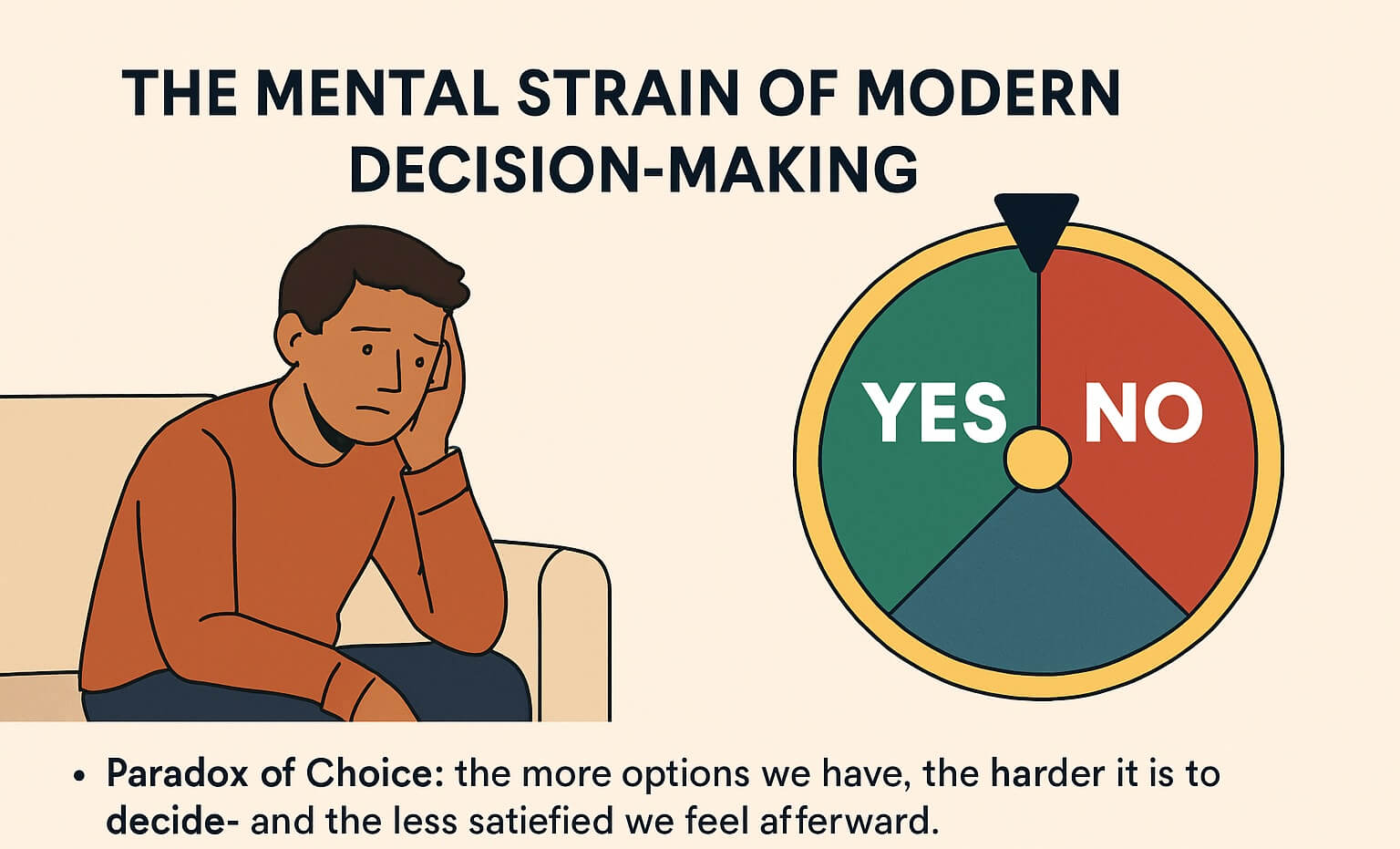
Decision-making is now more stressful and tiresome than ever before. From deciding what to have for lunch to choosing a vocation, the smallest decisions sometimes feel too difficult. That is where simple methods such as the “Yes or No” Wheel come in the form of an electronic coin flip that enables us to make our decisions immediately. But why on earth do we believe it? Why does it feel so exhilarating to just let a wheel make the choice for us?
Let’s take a peek into the psychology of random choice and discover how this odd instrument really works.
The Mental Strain of Modern Decision-Making
Have you ever spent 30 minutes scrolling through Netflix before giving up and watching an old favorite? You’re not the only one. This is the Paradox of Choice, a psychological theory by Barry Schwartz which states: the more we have to choose from, the more difficult it becomes to make a decision and the less satisfied we are afterwards.
A research conducted by Iyengar & Lepper (2000) revealed that customers were ten times more likely to purchase jam when presented with 6 choices rather than 24. Having too many options will freeze us. Decision fatigue is the phenomenon where random decision helpers seem like a blessing. They avoid the pressure of overthinking and provide a break for our brains.
Tools like wheel decide yes or no help bypass this overwhelm by instantly narrowing your options to a binary choice, offering clarity when you’re caught in indecision.
Heuristics and the Cognitive Miser Theory
Human minds are programmed to conserve energy. Psychologists Fiske & Taylor explain we’re all cognitive misers; we like mental shortcuts (heuristics) better than complex analysis.
Nobel laureate psychologist Daniel Kahneman presented two systems of thought:
-
System 1: Fast, emotional, instinctive
-
System 2: Slow, logical, deliberate
Random devices such as the “Yes or No” wheel are attractive to System 1. They’re easy, don’t require any work, and provide us with immediate feedback that perfectly matches our brain’s energy-saving tendencies.
The Role of Emotion: Affect Heuristic in Action
Feelings have a large influence on decisions. The Affect Heuristic describes how decisions are usually made based on feelings instead of reasoning.
For instance, tossing a coin to determine if you should take a job offer may feel arbitrary. But in many cases, your emotional response to the outcome of relief or disappointment indicates what you really desire. That emotional insight is what provides you with clarity, even when the choice feels “random.”
In this way, the “Yes or No” wheel isn’t deciding for you. It’s showing your subconscious choice.
Why Random Tools Feel Rational
Why do we have faith in random results from a wheel or coin toss? Because they seem even. There’s no bias, no tampering, just randomness. And when we’re stumped, that semblance of impartiality is reassuring.
A Falk & Zimmermann (2004) study demonstrated that individuals employ randomizers not to relinquish choice but to make it clearer. When the coin read “Yes,” and the individual felt let down, they immediately realized they wished to respond with “No.” Random tools assist in avoiding mental noise and arriving at inner truth.
When the Wheel Actually Helps You Decide
The “Yes or No” wheel works best for:
-
Trivial decisions (e.g., Should I order takeout?)
-
Stuck moments (“I can’t decide between two decent options.”)
-
Emotional bottlenecks (When fear, guilt, or stress cloud logic)
It’s also widely used in:
-
Classrooms for student participation
-
Group activities (e.g., chore rotation)
-
Therapy sessions to reduce anxiety about choice
The ‘Yes or No’ Wheel as a Digital Solution
In the past, people flipped coins. Today, they spin digital wheels. The difference? Gamification.
The online “Yes or No” Wheel turns a moment of indecision into an engaging experience. It’s colorful, animated, and satisfying to use making decision-making feel less like a chore and more like a game.
And it’s accessible anytime, anywhere. This convenience adds to its appeal for those dealing with indecision, ADHD, or anxiety.
Criticisms and Limitations
While the wheel can be useful, it’s not a universal solution. Over-relying on randomizers can:
-
Undermine your decision-making confidence
-
Lead to poor outcomes in serious situations
Important life decisions like choosing a career, moving cities, or ending a relationship require more than chance. They demand reflection, values, and long-term thinking.
Use the wheel as a catalyst, not a crutch.
Conclusion
The psychology behind the “Yes or No” Wheel is deeper than it appears. It taps into our cognitive shortcuts, reduces the burden of too many choices, and even clarifies our emotional truths. In a world that overwhelms us with options, letting a wheel decide isn’t just fun it’s surprisingly smart.
So next time you’re stuck on a minor decision, give the wheel a spin. You might discover what you really wanted all along.